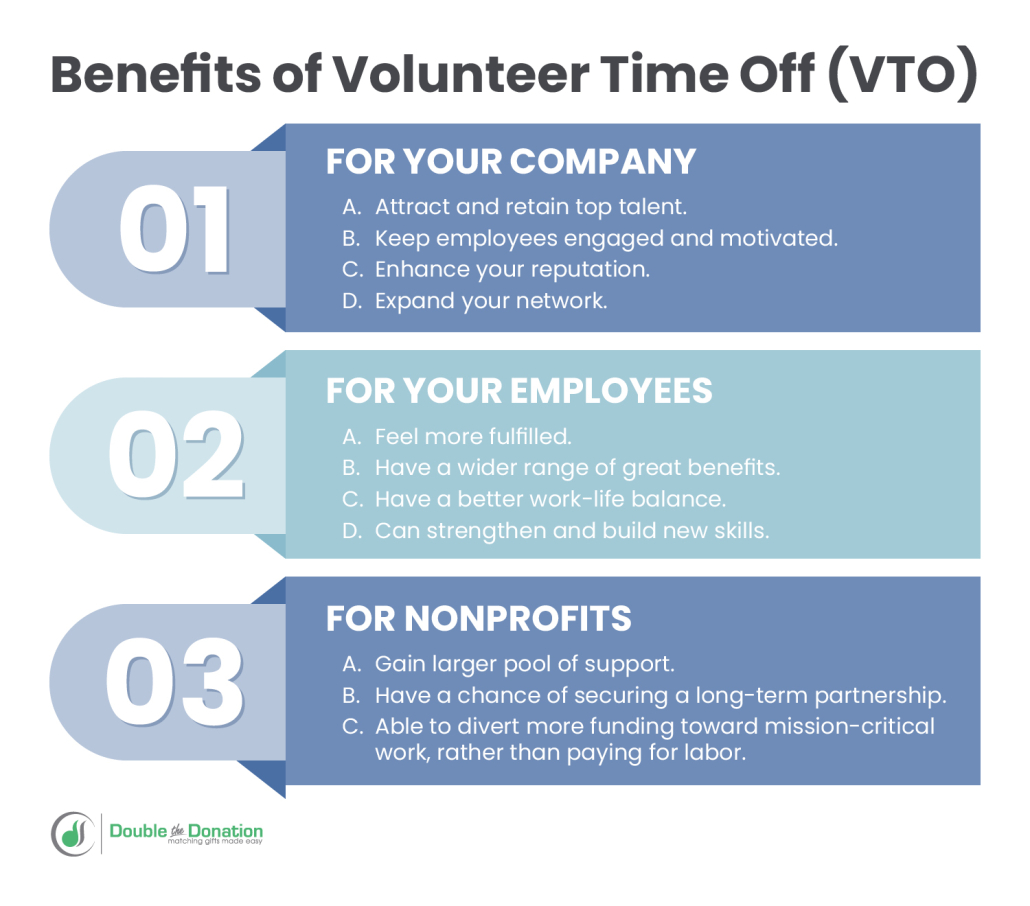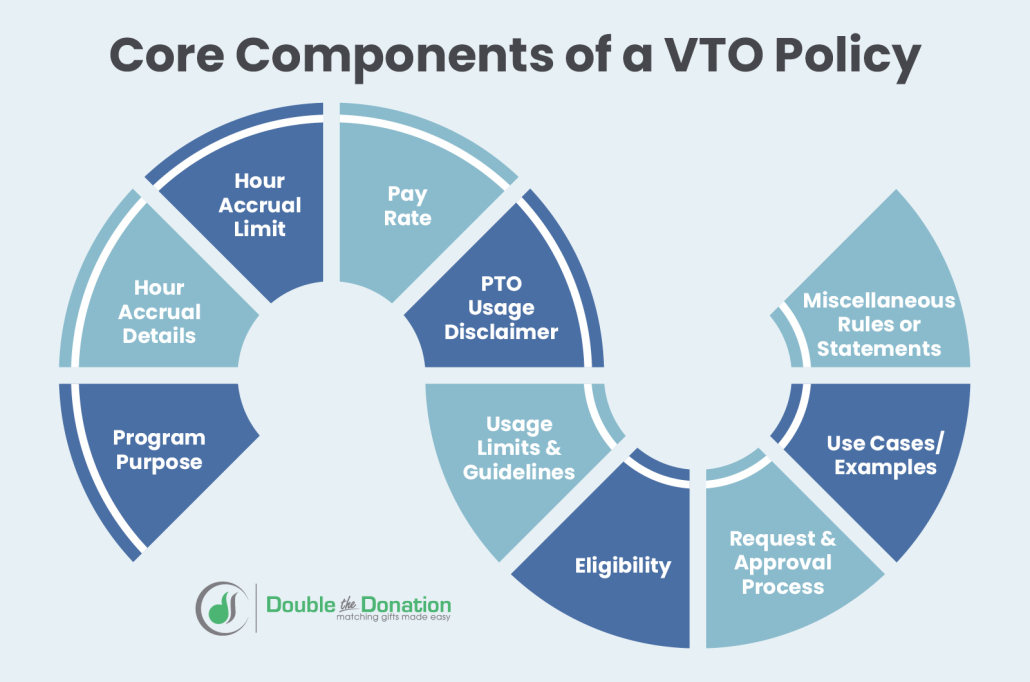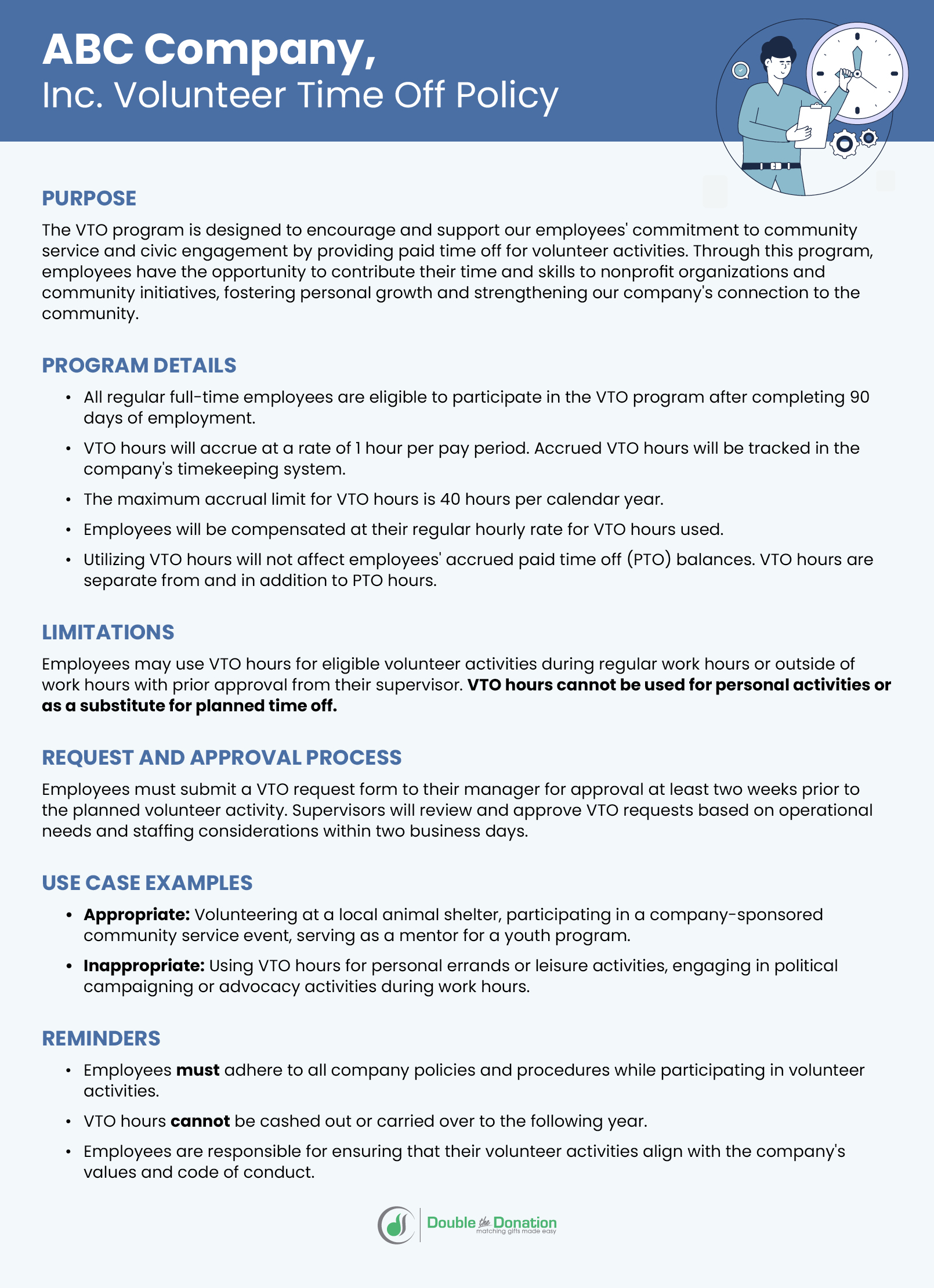An Eye-Opening Look at Volunteer Time Off Programs
Volunteerism is an essential part of many nonprofits’ operations, providing invaluable support at no cost to the organization. However, finding volunteers who have the time to dedicate to your cause can be difficult—especially when you have to consider the group’s existing work commitments. Fortunately, that’s where volunteer time off programs come in.
In this guide, we’ll cover all things volunteer time off and see how your organization can benefit from the programs by addressing the following frequently asked questions:
- What is volunteer time off?
- What are the benefits of volunteer time off?
- What does VTO look like in practice?
- How do businesses create volunteer time off policies?
- How can a nonprofit uncover VTO opportunities?
- What are some other ways companies give back?
Before getting into the details, we’ll break down the basics of volunteer time off and differentiate it from other workplace benefits. Let’s get started!
What is volunteer time off?
Volunteer time off (VTO) is paid time off a company gives its employees to spend performing volunteer work for charitable causes.
For example, perhaps a hurricane impacts a Houston-based company’s community. Many of the company’s employees spring into action to assist those affected by using their VTO hours to work with FEMA. Rather than being stuck at their desks, these individuals are getting paid to provide food, water, shelter, and supplies to their community. And they support nonprofits while they’re at it!
VTO is often just one piece of a business’s corporate social responsibility (CSR) program, which encompasses all of the company’s efforts to promote social good by supporting nonprofits, practicing sustainability, operating ethically, and more. We’ll discuss more ways businesses give back later.
Volunteer Time Off vs. Voluntary Time Off
You may have heard the term “voluntary time off” and assumed it is the same as “volunteer time off.” While these terms sound similar (and even use the same acronym!), they have very different functions in the workplace.
Here are the key differences between each term:
- Volunteer Time Off
- Paid
- Purpose is to encourage employees to volunteer during the workday without sacrificing compensation or PTO
- Example: An employee taking a morning off from work to volunteer at an elementary school library.
- Voluntary Time Off
- Unpaid
- Purpose is to give employees the option to take unpaid leave without risking their employment status or benefits
- Example: An employee takes a morning off from work to handle a personal appointment.
Volunteer Time Off Example: Hasbro
So, what do VTO policies look like in the real world? Double the Donation’s guide to VTO programs highlights what some of the top companies offer—we’ll explore just one as an example.

Hasbro is an American company that sells children’s games, toys, and entertainment. It has a robust employee volunteer program called Team Hasbro.
As a part of this program, Hasbro employees can accumulate up to 48 hours of VTO per year. Employees are granted four hours of VTO each month to use (or save) as they wish. In addition to its volunteer program, Hasbro also offers matching gifts (more on these later!).
What are the benefits of volunteer time off?
It’s easy to see why volunteer time off is beneficial. It gives employees more flexibility to get involved with the causes they care about, and it allows businesses to support their communities in meaningful ways. However, being familiar with all of the advantages of VTO can go a long way.
Here’s how these programs can benefit businesses, their employees, and the nonprofits they support:

Benefits for Companies
Understanding the benefits of corporate volunteer programs like VTO from the business perspective allows organizations to effectively communicate their value to businesses—and get them on board with the opportunity. Check out the key advantages for companies below:
- Attracting and retaining more employees: 71% of employees say that it’s important to work at a company that gives back to the community through philanthropy and volunteering. Businesses that offer VTO appeal to these employees by implementing and advertising your volunteer time off policy and other CSR initiatives.
- Increasingly engaged staff: VTO helps employees do more of what truly matters to them. For companies, supporting their efforts to make a difference and permitting them to take the time to volunteer during work hours will make them feel more valued and appreciated—all leading to better performance and productivity at work.
- Enhanced reputation: When a business publicly supports nonprofits, whether through financial donations or volunteer efforts, it can strengthen its reputation as a company that cares about its community and overall social good.
- Expanded professional networks: Companies can build connections in their community through their volunteer efforts, getting to know the leaders of local nonprofits and connecting with their staff and other volunteers. Who knows? An employer may meet a future employee at a volunteer opportunity or discover other ways to support the nonprofit by talking with a board member.
Benefits for Employees
Similarly, you’ll want to be able to understand and communicate the value of VTO for participating companies’ employees—especially when those employees are your volunteers! Here are a few key benefits to note:
- Help employees feel more fulfilled: Everyone has hobbies, interests, and causes that make them feel complete outside of the work they do from nine to five. A company’s VTO policy brings those causes into their nine-to-five, helping employees feel more fulfilled and making it easier to get involved with the organizations they care about.
- Offer more competitive benefits: Compensation and other competitive benefits help businesses attract top-tier talent. VTO falls in line with other benefits, like bonuses or hybrid work schedules, which enrich a compensation package, adding more value than a salary could on its own.
- Foster better work-life balance: Employees likely have busy schedules, especially if they have kids, pets, or other obligations. VTO gives them more time to do the things they truly value, like volunteering with a local animal shelter, without sacrificing pay or PTO hours.
- Facilitate skill-building: Some volunteer opportunities give employees the chance to practice or hone their skills in a new setting. For example, perhaps employees at a hair salon regularly volunteer at a homeless shelter to provide free haircuts. During their shifts, they get experience working with different hair types, styles, and ages, ultimately improving their abilities.
Benefits for Nonprofits
Finally, you don’t want to overlook the benefits made available to your organization through companies’ VTO programs:
- Growth in volunteer participation: VTO programs ensure a steady stream of volunteers since employees are encouraged by their companies to give back during paid working hours.
- Access to valuable skills: Employees volunteering through VTO often bring specialized skills in areas like marketing, finance, IT, or project management, enhancing the quality of work delivered to the nonprofit.
- Stronger corporate partnerships: Nonprofits can build long-term relationships with companies offering VTO, potentially opening doors to financial donations, sponsorships, or other in-kind support.
- Increasingly cost-effective workforce: Volunteers (particularly those engaging through VTO programs) provide free labor, helping nonprofits expand their services without the financial burden of hiring additional staff. These individuals can help with a wide range of projects and activities, giving nonprofits flexibility in completing tasks without overextending their budgets. After all, the value of a volunteer hour is estimated at $31.80, meaning that nonprofits would have to pay that much for a paid worker’s time.
- Improved community impact: VTO initiatives can enhance a nonprofit’s ability to serve more beneficiaries, helping to scale their programs and make a larger impact in the community.
What does VTO look like in practice?
When you think about how VTO works in practice, you might envision a supporter leaving their shift early to volunteer with their favorite organization. However, there are many ways individuals can utilize VTO, such as:
- Individual volunteering, in which employees generally identify, schedule, and participate in volunteer opportunities on their own.
- Group or company-organized volunteering, where groups of employees join together to give nonprofits even more helping hands. Employees may form these groups on their own, though businesses can also organize a company-wide volunteer shift.
- Skill-based efforts in which employees offer to perform a certain skill for a nonprofit, free of charge. This may be anything from offering pro-bono law services to preparing food.
- Emergency or disaster response teams which are put together quickly to lend aid to the community after a crisis. This could be in response to severe weather, tragic events, crimes, fires, and more.
For example, let’s say a dog daycare business implements a VTO policy for its employees. Those employees might group together to lend their various skills to a local dog rescue. While an on-site groomer can help bathe the dogs and trim nails, a behavior specialist might teach the dogs a few basic tricks. Then, the dog daycare business could also organize company-wide volunteer days to walk the dogs, socialize puppies, and clean out kennels.
How do businesses create volunteer time off policies?
For companies looking to implement a volunteer time off program, it’s important to summarize the stipulations of the initiative in the appropriate employee materials. This way, team members can easily reference the guidelines to get involved with their favorite causes at any time.
For nonprofits, understanding how to read a volunteer time off policy is equally important to ensure their teams are able to target the programs effectively.
Because we’re familiar with tons of companies’ VTO policies, we’ve compiled some expert tips for those looking to draft their guidelines.
VTO Policy Structure
There are a few key elements businesses need to include in their policies, such as:

- The purpose of the program. Briefly explain the purpose of the program (e.g., to better the community). Knowing the reason behind the programs gives employees more context about the decision and can help them better understand how to use their VTO hours.
- Hour accrual details. Explain how employees will accrue hours. For example, they might earn one VTO hour per biweekly pay period.
- Hour accrual limit. There’s generally a specific cap on how many VTO hours an employee can save up during a set time period. For example, companies often limit the number of hours to between 8 and 40 VTO hours per year.
- VTO pay rate. Note that employees will be paid their standard rate during VTO. This will assuage any concerns about sacrificing pay to volunteer.
- Impact on PTO usage. While VTO should not reduce an employee’s available PTO hours, there may require clarification for certain situations. For example, if a company enacts a limit on how many PTO hours an employee can use per month, how does VTO factor into that policy?
- Usage limits or guidelines. Decide on other usage guidelines to ensure employees are leveraging the program the way it was envisioned. For example, a company might limit employees to a maximum of two volunteer days per month and require that each volunteer opportunity be at least three hours long.
- Eligibility. Outline which employees are eligible to accrue and use VTO hours. For example, employees may be required to have worked for the business for at least three months and be full-time.
- Request and approval process. Walk through how employees can request their volunteer time off, and include or link to the request form. Lay out any rules about these requests, such as how far in advance employees need to put them in, what information they must provide, and who to send them to.
- Examples of appropriate and inappropriate use cases. To make sure all of your employees are on the same page, include examples of proper and improper use of the program. An “appropriate” example could be cleaning up a beach or park, while an “inappropriate” example might be vacationing in Hawaii and providing free surfing lessons.
- Miscellaneous guidelines or rules. Finally, list any other guidelines that may be relevant during the program, such as a cash-out policy, how to log hours, and how to obtain “proof” of the volunteer experience.
Including each of these elements is critical to the success of your program and reducing miscommunications with employees. Your HR team, company leaders, financial professionals, and any other major stakeholders will need to collaborate to build out the policy and ensure everyone is on the same page.
Sample VTO Policy
Every company’s VTO policy will look different depending on its needs, budget, other time off policies, and more. We put together a quick example that can help you get an idea of how these policies are structured.

ABC Company, Inc. Volunteer Time Off Policy
Purpose
The VTO program is designed to encourage and support our employees’ commitment to community service and civic engagement by providing paid time off for volunteer activities. Through this program, employees have the opportunity to contribute their time and skills to nonprofit organizations and community initiatives, fostering personal growth and strengthening our company’s connection to the community.
Program Details
- All regular full-time employees are eligible to participate in the VTO program after completing 90 days of employment.
- VTO hours will accrue at a rate of 1 hour per pay period. Accrued VTO hours will be tracked in the company’s timekeeping system.
- The maximum accrual limit for VTO hours is 40 hours per calendar year.
- Employees will be compensated at their regular hourly rate for VTO hours used.
- Utilizing VTO hours will not affect employees’ accrued paid time off (PTO) balances. VTO hours are separate from and in addition to PTO hours.
Limitations
Employees may use VTO hours for eligible volunteer activities during regular work hours or outside of work hours with prior approval from their supervisor. VTO hours cannot be used for personal activities or as a substitute for planned time off.
Request and Approval Process
Employees must submit a VTO request form to their manager for approval at least two weeks prior to the planned volunteer activity. Supervisors will review and approve VTO requests based on operational needs and staffing considerations within two business days.
Use Case Examples
- Appropriate: Volunteering at a local animal shelter, participating in a company-sponsored community service event, serving as a mentor for a youth program.
- Inappropriate: Using VTO hours for personal errands or leisure activities, engaging in political campaigning or advocacy activities during work hours.
Reminders
Employees must adhere to all company policies and procedures while participating in volunteer activities.
VTO hours cannot be cashed out or carried over to the following year.
Employees are responsible for ensuring that their volunteer activities align with the company’s values and code of conduct.
Encouraging Adoption
These programs can take large investments of time and resources to get up and running. Additionally, leaders and stakeholders want to see the benefits we discussed earlier come to life as a result of the program. That’s why it’s vital for companies to also promote the programs to employees and encourage them to participate by…

- Getting them involved. Have employees weigh in on which causes the business will support. When they know that their dollars or volunteer hours will go toward a cause they deeply care about, they’ll be much more likely to engage with the program. Additionally, make sure to gather and implement employee feedback on the program to continuously improve it.
- Promoting opportunities. Share frequent reminders about your CSR programs with employees to motivate them to participate. For example, create an event invitation for a volunteer excursion and remind employees to register in advance. Or, you might remind them of an available matching gift program during the holiday season when more people tend to donate.
- Recognizing their efforts. When employees participate, reward their efforts with recognition. Using a recognition platform of choice, send them a quick eCard or note thanking them for their time or contribution. This affirms that they are making a difference by engaging with the company’s CSR initiatives.
- Offering incentives. In addition to recognizing employees, you might also reward them with tangible incentives. These could be simple gifts like company swag or restaurant gift cards. Or, offer bonus PTO for joining a group volunteer shift.
- Leading by example. Get leaders involved to show employees that giving back is an important part of the company culture. Senior executives, managers, and other leaders should regularly participate in efforts like VTO to highlight the significance of promoting social good.
Finally, remind employees about what really matters. Their efforts bring more support to nonprofits, which drives meaningful change for nonprofits, their beneficiaries, and the community. After all, help from your employees can fill hungry bellies, find homes for shelter animals, and even transform dirty beaches into clean, safe environments for wildlife.
At the same time, nonprofits are also increasingly taking the time to market VTO programs to their supporters, which can help supplement (but not replace!) a company’s own promotional efforts.
How can a nonprofit uncover VTO opportunities?
Uncovering volunteer time off (or VTO) programs within a nonprofit’s community can significantly enhance the organization’s volunteer recruitment and engagement strategy. But how exactly can you get started?
Here’s what we recommend:
- Collect employment information from donors and volunteers. Knowing where your supporters work is the first step to identifying VTO opportunities available to you. It’s a good idea to solicit this information on your donation forms, volunteer registration pages, and more to ensure the fullest coverage of your network.
- Invest in a corporate volunteer incentives database tool. Most individuals won’t know off the top of their heads whether their company offers volunteer time off. Rather than asking them to do the research themselves, provide them with a handy tool (like Double the Donation’s Volunteering plugin). With a quick search of a company name. users can access program guidelines, links to submission request forms, and instructions for getting involved.
- Market VTO programs on your website and registration forms. Because there’s a widespread lack of awareness regarding volunteer time off programs, promoting the opportunity well can go a long way in driving participation in your organization. Some of your best marketing assets for this task include your website (specifically a Volunteers page!) and volunteer sign-up forms. And, if you invest in a database tool, you can embed the widget in both of these locations to increase visibility and engagement.

You can also do research into top companies offering volunteer time off programs (check out some leading examples here), then compare against your own supporters’ employers.
What are some other ways companies give back?
Partaking in CSR is a great way for a business to cement itself as one that goes above and beyond to serve its community and the greater good. Practicing CSR can have huge benefits for companies in acquiring the best employees, making connections with social good organizations, and building deep bonds with customers. After all, customers are more than four times more likely to purchase from a company with a strong purpose.
Fortunately, most companies’ CSR efforts don’t stop at offering VTO to your employees. In fact, there are so many initiatives that can and will be established as part of a full-fledged charitable giving policy. These programs offer numerous benefits to organizations like yours and include:
- Matching gifts: In a matching gift program, a business matches the donations that employees make to charitable causes, usually at a 1:1 ratio. This means that you can double incoming donations without asking your supporters to give more.
- Volunteer grants: These monetary grants are given to the organizations with which a company’s employees volunteer. Say an employee volunteers with a nonprofit each weekend for four hours—once they reach their employer’s minimum hour threshold (usually 10 to 20 hours), the nonprofit is eligible for a volunteer grant!
- Corporate grants: These grants are standard financial donations to nonprofits that may align with a particular project or activity. Companies may create an application process for organizations or simply choose a nonprofit they’d like to support.
- Sponsorships: A corporate sponsorship is used to fund specific nonprofit events, projects, or programs. Sometimes, a business may receive something in exchange for these sponsorships—such as inclusion within marketing materials or event signage.
- Payroll giving: Also known as automatic payroll deductions, payroll giving allows your employees to donate directly from their regular paychecks. Similar to contributing to their retirement or savings account, they can route a portion of their check to a nonprofit each month or pay period. This is a great way to encourage regular support and make giving as easy as possible.
Corporate philanthropy makes up a significant portion of nonprofit support each year, and programs like these can play an essential role. As a nonprofit, becoming familiar with such initiatives will allow you to identify and pursue the opportunities with ease. Meanwhile, companies can explore new ways to expand their giving!
Wrapping Up
Volunteer time off gives employees the freedom they need to volunteer with their favorite organizations regularly. Not only will they help important nonprofits (like yours!) do more to promote their missions, but they’ll also feel more fulfilled, valued, and productive while at work.
If you’re interested in learning more about volunteer time off, we recommend exploring the following resources:
- 23+ Corporate Volunteer Ideas to Build a Better Community. Need inspiration for how to invigorate your corporate volunteers? Check out these creative ideas.
- Top Volunteer Time Off Companies | 35 Programs to Know. See if your volunteers work for companies with generous VTO programs. Browse our compilation of top employers!
- Standout Strategies for Leveraging Corporate Volunteer Incentives. Volunteer incentives like VTO can go a long way in driving engagement with your cause. Make the most of these programs here.





